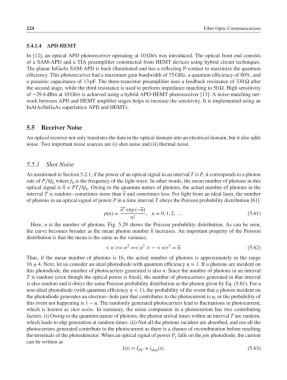Page 243 - Fiber Optic Communications Fund
P. 243
224 Fiber Optic Communications
5.4.1.4 APD-HEMT
In [12], an optical APD photoreceiver operating at 10 Gb/s was introduced. The optical front end consists
of a SAM-APD and a TIA preamplifier constructed from HEMT devices using hybrid circuit techniques.
The planar InGaAs SAM-APD is back-illuminated and has a reflecting P-contact to maximize the quantum
efficiency. This photoreceiver had a maximum gain bandwidth of 75 GHz, a quantum efficiency of 80%, and
a parasitic capacitance of 13 pF. The three-transistor preamplifier uses a feedback resistance of 330 Ω after
the second stage, while the third resistance is used to perform impedance matching to 50 Ω. High sensitivity
of −29.4 dBm at 10 Gb/s is achieved using a hybrid APD-HEMT photoreceiver [13]. A noise-matching net-
work between APD and HEMT amplifier stages helps to increase the sensitivity. It is implemented using an
InAlAs/InGaAs superlattice APD and HEMTs.
5.5 Receiver Noise
An optical receiver not only translates the data in the optical domain into an electrical domain, but it also adds
noise. Two important noise sources are (i) shot noise and (ii) thermal noise.
5.5.1 Shot Noise
As mentioned in Section 5.2.1, if the power of an optical signal in an interval T is P, it corresponds to a photon
rate of P∕hf where f is the frequency of the light wave. In other words, the mean number of photons in this
0
0
optical signal is n = PT∕hf . Owing to the quantum nature of photons, the actual number of photons in the
0
interval T is random–sometimes more than n and sometimes less. For light from an ideal laser, the number
of photons in an optical signal of power P in a time interval T obeys the Poisson probability distribution [61]
n
n exp (−n)
p(n)= , n = 0, 1, 2, … (5.61)
n!
Here, n is the number of photons. Fig. 5.29 shows the Poisson probability distribution. As can be seen,
the curve becomes broader as the mean photon number n increases. An important property of the Poisson
distribution is that the mean is the same as the variance,
2 2 2
< n >= =< n > − < n> = n. (5.62)
Thus, if the mean number of photons is 16, the actual number of photons is approximately in the range
16 ± 4. Next, let us consider an ideal photodiode with quantum efficiency = 1. If n photons are incident on
this photodiode, the number of photocarriers generated is also n. Since the number of photons in an interval
T is random (even though the optical power is fixed), the number of photocarriers generated in that interval
is also random and it obeys the same Poisson probability distribution as the photon given by Eq. (5.61). For a
non-ideal photodiode (with quantum efficiency < 1), the probability of the event that a photon incident on
the photodiode generates an electron–hole pair that contributes to the photocurrent is , or the probability of
this event not happening is 1 − . The randomly generated photocarriers lead to fluctuations in photocurrent,
which is known as shot noise. In summary, the noise component in a photocurrent has two contributing
factors. (i) Owing to the quantum nature of photons, the photon arrival times within an interval T are random,
which leads to ehp generation at random times. (ii) Not all the photons incident are absorbed, and not all the
photocarriers generated contribute to the photocurrent as there is a chance of recombination before reaching
the terminals of the photodetector. When an optical signal of power P falls on the pin photodiode, the current
I
can be written as
I(t)= I PC + i shot (t), (5.63)

